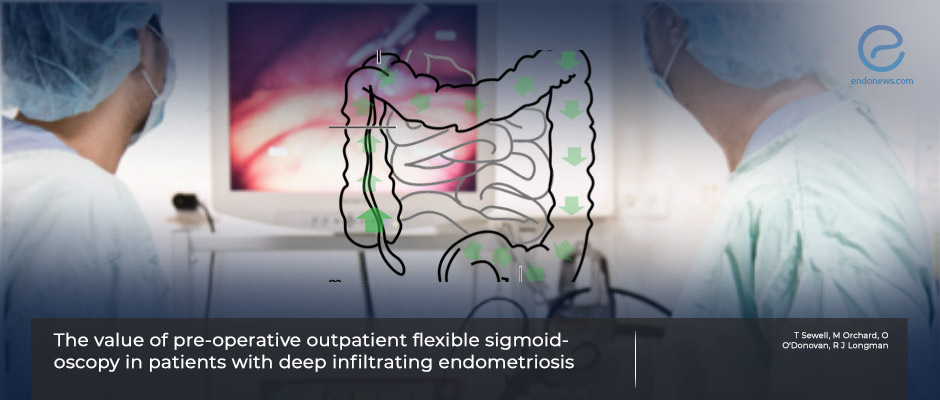Preoperative flexible sigmoidoscopy in patients with deep infiltrating endometriosis
Aug 30, 2023
Flexible sigmoidoscopy should not be a routine procedure before deep infiltrating endometriosis surgery because of the low incidence of luminal endometriosis.
Key Points
Highlights:
- Outpatient flexible sigmoidoscopy should be applied to women with deep infiltrating endometriosis to differentiate suspicious serious pathology such as colorectal neoplasia or to plan the location of subsequent resectional surgery.
Importance:
- Women with deep infiltrating endometriosis who will undergo surgical procedures should be informed about the necessity of flexible sigmoidoscopy.
What’s done here?
- This retrospective observational case series study was conducted to clarify the necessity of outpatient flexible sigmoidoscopy use prior to surgery for deep infiltrating endometriosis.
- All women with confirmed or suspected rectovaginal deep endometriosis who underwent preoperative flexible sigmoidoscopy were included.
- The participants were managed by a team experienced in endometriosis including gynecologists, specialist nurses, and a colorectal surgeon.
- Flexible sigmoidoscopy was performed to exclude luminal endometriosis and to counsel patients prior to surgery.
- The primary outcome was the incidence of luminal disease diagnosed during flexible sigmoidoscopy while the secondary outcome was the presence of other pathologies, technical feasibility, and complications of the procedure.
Key results:
- A total of 102 patients with suspected or confirmed rectovaginal deep endometriosis who underwent preoperative flexible sigmoidoscopy were included.
- Rectovaginal endometriosis was confirmed in 91 patients (89.2%) whereas deep endometriosis was not at surgery in 9 patients (8.7%).
- Outpatient flexible sigmoidoscopy was applied completely in 95 women (93.1% of the participants).
- Only a single case was diagnosed with suspected partial-thickness rectal wall involvement.
- The most common abnormal findings for non-specific rectovaginal nodules during digital rectal examination consisted of palpable tender nodules, tightly angulated rectum and/or colon, and fixed sigmoid colon.
- There were no specific sigmoidoscopy-related specific complications.
- The overall risk of requiring surgical management directly to the bowel (bowel resection, disc resection, and serosa repair) was 8%.
Strengths and Limitations
- The strength of the study is that this is an observational cohort study at a single tertiary referral center.
- Additionally, all procedures and operations were performed by the same experienced team in endometriosis.
- Retrospective, observational design could be accepted as the main limitation.
Lay Summary
Deep infiltrating endometriosis is defined as endometriotic lesions extending 5 mm or more below the peritoneal surface. Women with deep endometriosis have rectovaginal lesions affecting the tissue adjacent to, or directly involving the rectum and/or rectosigmoid colon with a 90% incidence. Deep endometriosis may be diagnosed or suspected with transvaginal ultrasound or magnetic resonance imaging in experienced hands. Routine flexible sigmoidoscopy is suggested in cases with suspicious rectovaginal deep endometriosis.
Sewell et al., from the United Kingdom, published a study titled “The value of pre-operative outpatient flexible sigmoidoscopy in patients with deep infiltrating endometriosis” in the journal Facts, Views and Vision in Obstetrics and Gynaecology.
The authors aimed to investigate the value of preoperative outpatient flexible sigmoidoscopy in women who underwent planned surgery for deep infiltrating endometriosis. The incidence of luminal disease diagnosed during flexible sigmoidoscopy was evaluated as the primary outcome while the secondary outcome was the presence of other pathologies, technical feasibility, and complications of the procedure. After the procedure of flexible sigmoidoscopy, a total of 100 patients were managed with surgery and the risk of bowel resection during surgery was 4%. Rectovaginal endometriosis was confirmed in 91 patients (89.2%) whereas deep endometriosis was not found at the time of surgery in 9 patients (8.7%).
“Due to the low incidence of luminal endometriosis, performing sigmoidoscopy routinely is of limited benefit.” the authors added.
Research Source: https://pubmed.ncbi.nlm.nih.gov/37436048/
endometriosis deep infiltrating endometriosis sigmoidoscopy

